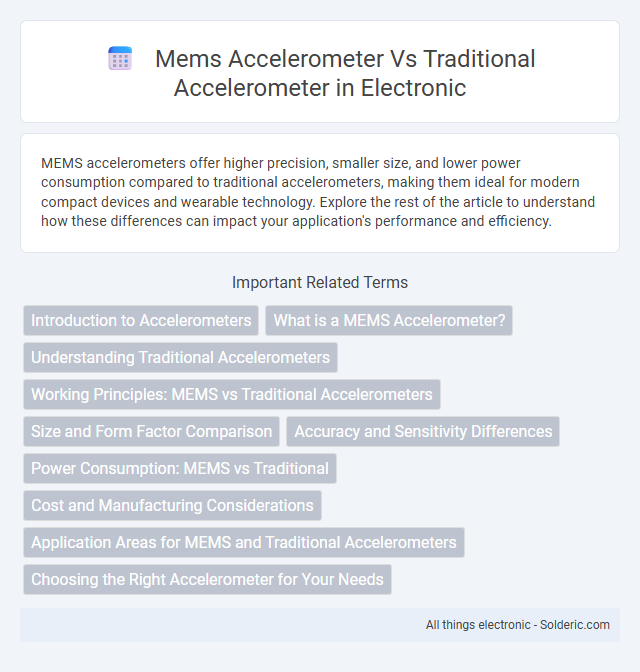MEMS accelerometers offer higher precision, smaller size, and lower power consumption compared to traditional accelerometers, making them ideal for modern compact devices and wearable technology. Explore the rest of the article to understand how these differences can impact your application's performance and efficiency.
Comparison Table
| Feature | MEMS Accelerometer | Traditional Accelerometer |
|---|---|---|
| Technology | Micro-Electro-Mechanical Systems (MEMS) | Piezoelectric, capacitive, or servo-based mechanisms |
| Size | Compact, typically millimeter scale | Larger, bulkier devices |
| Weight | Lightweight, grams or less | Heavier, grams to tens of grams |
| Cost | Low cost, mass-produced | Higher cost, complex manufacturing |
| Power Consumption | Low power, ideal for battery operation | Higher power consumption |
| Durability | Robust, resistant to shock and vibration | More fragile, sensitive to mechanical stress |
| Accuracy | Good for general applications, moderate accuracy | High accuracy and precision |
| Frequency Response | Limited high-frequency response | Better frequency response |
| Applications | Consumer electronics, automotive, wearables, IoT | Industrial, aerospace, scientific instruments |
Introduction to Accelerometers
MEMS accelerometers use microelectromechanical systems technology to measure acceleration by detecting changes in capacitance between tiny moving structures, offering compact size and low power consumption. Traditional accelerometers often rely on piezoelectric or capacitive sensing with larger, bulkier mechanical components that provide high accuracy but can be less suitable for portable applications. Your choice depends on the need for miniaturization and integration, with MEMS accelerometers excelling in consumer electronics and wearable devices.
What is a MEMS Accelerometer?
A MEMS accelerometer is a microelectromechanical system device that measures acceleration forces using tiny mechanical components integrated with electronic circuits on a single chip. Unlike traditional accelerometers that rely on larger, bulkier parts, MEMS accelerometers offer high precision, compact size, and low power consumption, making them ideal for smartphones, wearables, and automotive applications. Your choice of sensor technology affects device responsiveness and accuracy, with MEMS accelerometers providing enhanced performance in space-constrained environments.
Understanding Traditional Accelerometers
Traditional accelerometers use mechanical components like springs and masses to measure acceleration by detecting displacement caused by inertial forces. These devices often rely on piezoelectric or capacitive sensing methods to convert physical movement into electrical signals. Understanding traditional accelerometers helps you appreciate the evolution and advantages of MEMS accelerometers in terms of size, power consumption, and integration capabilities.
Working Principles: MEMS vs Traditional Accelerometers
MEMS accelerometers operate using microelectromechanical systems that detect changes in capacitance caused by the movement of tiny suspended masses, enabling precise acceleration measurement at a miniature scale. Traditional accelerometers typically rely on piezoelectric or piezoresistive elements that generate voltage or resistance changes due to mechanical stress from acceleration forces. Your choice between MEMS and traditional accelerometers depends on requirements for size, sensitivity, and integration with modern electronics.
Size and Form Factor Comparison
MEMS accelerometers typically measure just a few millimeters in size, enabling compact, lightweight designs ideal for portable electronics and wearable devices. Traditional accelerometers are bulkier, often requiring larger packaging and more support circuitry, which limits their integration into small-scale applications. The smaller form factor of MEMS accelerometers enhances device miniaturization without compromising sensitivity or performance.
Accuracy and Sensitivity Differences
MEMS accelerometers offer higher sensitivity due to their micro-scale mechanical structures, enabling detection of minute vibrations and low-frequency movements with precision. Traditional accelerometers, often based on piezoelectric or capacitive principles, provide robust accuracy in higher dynamic ranges but may lack the fine resolution of MEMS devices. The semiconductor fabrication process in MEMS ensures consistent performance and enhanced signal-to-noise ratio, making them superior for applications requiring precise motion sensing.
Power Consumption: MEMS vs Traditional
MEMS accelerometers exhibit significantly lower power consumption compared to traditional accelerometers due to their microfabrication design and smaller scale of moving components. This efficiency makes MEMS devices ideal for battery-powered applications such as smartphones, wearable devices, and IoT sensors where energy conservation is crucial. Traditional accelerometers, often utilizing bulkier mechanical parts or piezoelectric materials, generally require higher power, limiting their use in low-power environments.
Cost and Manufacturing Considerations
MEMS accelerometers offer significant cost advantages over traditional accelerometers due to their scalable batch manufacturing processes using semiconductor fabrication techniques. The smaller size and integration capabilities of MEMS devices reduce material usage and assembly complexity, lowering overall production expenses. Your choice of sensor can impact budget efficiency, especially in high-volume applications requiring compact, cost-effective solutions.
Application Areas for MEMS and Traditional Accelerometers
MEMS accelerometers excel in consumer electronics, automotive safety systems, and wearable devices due to their compact size, low power consumption, and cost-effectiveness, making them ideal for integration into smartphones and fitness trackers. Traditional accelerometers are preferred in aerospace, industrial machinery, and seismic monitoring where higher accuracy, durability, and performance under extreme conditions are critical. Understanding these application areas helps you select the appropriate accelerometer type based on precision requirements and environmental constraints.
Choosing the Right Accelerometer for Your Needs
MEMS accelerometers offer compact size, low power consumption, and cost-effectiveness, making them ideal for consumer electronics and wearable devices requiring precise motion detection. Traditional accelerometers, often piezoelectric or capacitive types, provide higher sensitivity and durability for industrial applications needing robust performance under extreme conditions. Selecting the right accelerometer depends on application requirements such as measurement range, frequency response, size constraints, and environmental factors.
mems accelerometer vs traditional accelerometer Infographic

 solderic.com
solderic.com